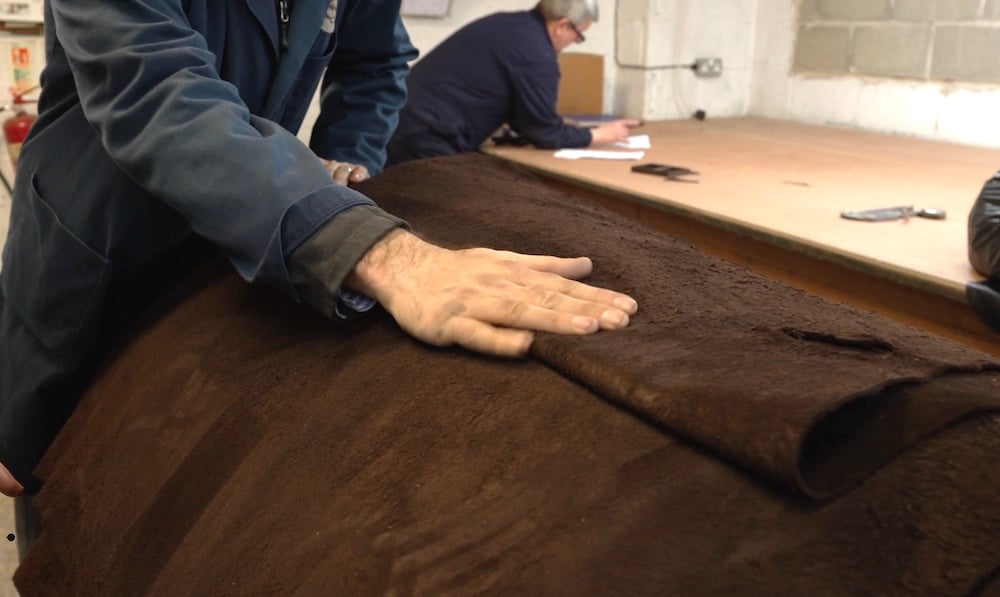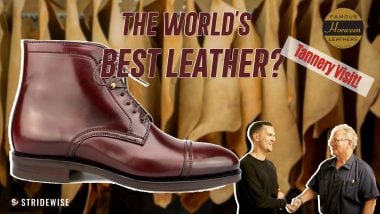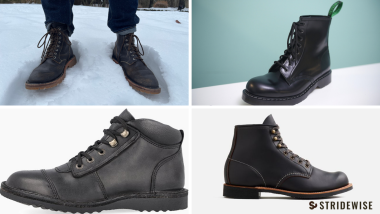Tannery Visit: How CF Stead Makes the World’s Best Suede
From the highest-end luxury shoes made in the UK and North America to the most widespread suede footwear on the market, like Clarks and their desert boot, there is zero question that Charles F. Stead makes some of the most highly regarded suede on the planet.
There’s a lot you don’t know about suede. The Leeds-based tannery products dozens of articles, some of which are thin and supple, some of which will make the most hard wearing and weatherproof footwear you’ll ever find.
“Depending on the construction, a shoemaker is going to use one-millimeter to two-millimeter thick leather,” says C.F. Stead’s Sales Director Andrew Bailey. “For heavier use, two-point-five, perhaps even three millimeters. But you can get that same thickness from suede. It just depends on which side of the hide you’re using, how it’s been treated, and how it’s been tanned.”
From the ultra robust Waxy Commander to the luxurious Janus Calf, there’s a suede to suit every need — and C.F. Stead makes it. To our delight, they granted our request to visit their tannery and document their never-before-seen process. Watch the journey below.
The History of CF Stead
With a rich history spanning some 130 years, C.F. Stead’s story is a tapestry woven with tradition, evolution, and an unwavering commitment to excellence. Founded in 1904 by the Charles Frederick Stead, the company’s humble beginnings saw it as a modest tannery focused on producing sheepskin leather for book bindings, chamois, and bags.
The 1920s saw the rise of what Stead calls “the Englishman’s love affair with suede shoes.” Edward, Duke of Windsor, was considered the best dressed man of the decade, and caused a famous stir when he paired brown suede shoes with a navy suit. C.F. Stead leaned in.
“The production changed during the war period, but for the last sixty-five years, there’s been a real focus on making premium suedes,” says Bailey. “What we saw here today remains an absolutely key part of our business and what we’re best known for in the global market.”

In the 2000s, Stead began experimenting with what would become another of its flagship materials: kudu leather. Using skins taken from the annual wild antelope cull, Stead helped to popularize this intriguing leather that shows blemishes, cuts, and grazes from the animal’s lives in the wild. No two hides are alike, and with time and proper positioning in the market, customers began to value that.
As the years passed, C.F. Stead honed their recipes to embrace technological advancements while honoring the traditional techniques that define their heritage. Progressing from glove leather to premium suede — from local recognition to global prominence — led to the words “Stead suede” being universally understood as signifying high quality.

How Does C.F. Stead Makes the Best Suede?
Creating top-tier suede is a multifaceted endeavor that demands a blend of skill and precision, although the initial step of tanning raw hides into the “wet blue” state happens elsewhere.
“A wet blue hide is a hide that’s been chrome tanned,” says Michael Crack, the tannery’s technical director. “Effectively, it is leather when it comes to us, because it’s been permanently preserved.”
But there are weeks of work before we have the suede that Stead is known for.
Rejuvenation and Anti-Mould Treatment
Transportation can leave hides dehydrated, so they’re first washed to rehydrate, clean, and add anti-mould. They’re then dehydrated to ensure uniform moisture content of about 50 percent. The machine above squeezes out moisture, with the pinwheels measuring the area and thickness before they’re batched in accordance with their thickness.
Shaving
Once they know the thickness of all the hides, they can be shaved. This isn’t removing hair: shaving carefully reduces the leather’s thickness, revealing the fleshy fibers of the suede. Because these flesh fibers are somewhat loose, they result in a fuzzy surface.
“Every tannery has got their own configuration of the blades that gives you the best cutting,” says Crack. “My grandfather created that back in the 1950s, and it’s every suede tannery’s secret.”
Dye Drums
“These drums hold 1400 kilos of wet blue shaved weight, and each process is two days,” says Crack. Some drums hold 400kg, others 600kg, so there are a variety of vessels for different sized loads. They’re more modern than the drums you find in less regulated tanneries that make cheaper leather: they’re easy to clean, lightweight, chemical resistant, energy efficient, and automatic.
Horsing (Removing creases)
Once the wet hides are taken out of the dye drums, they’re flattened out over “horses” to remove the creases.
“It’s very heavy work, and if it’s not done correctly, then obviously, you can put some creases into the material,” says Crack.
Drying the Hides Again
The hides are then dried and flattened in a machine that functions somewhat like an iron on a conveyor belt, heating the suede and squeezing out liquid, before more moisture is removed by hang drying.
“It’ll be about 10% moisture content,” Crack explains. “The fibers are drawn together. It’s the start of the very tight fiber structure that Steads are known for. You want a nice, tight fiber structure so that when you buff it, it presents the nap in a nice, even level with velour and structure. It makes it very tough, very durable, and long lasting.”
Shrunken suedes, like the Rambler, are particularly hardwearing variants that have a tighter, denser fiber structure. This makes the leather more hardwearing, less porous, and less likely to stretch.
Drum Conditioning
Then there’s yet another step where the hide gets hydrated after being dehydrated (after being rehydrated after dehydrated…) but here they’re being infused with an array of oils and waxes that will keep the leather moist and durable after it leaves the tannery. The precise makeup of the conditioning materials here depends on the final product’s intended purpose, with oilier leathers being better suited for harder wear because of their hydrophobic nature.
“It’s about the uniformity of the material, really,” says Crack. “It’s about making it the same moisture content from pack to pack to pack.”
Toggling
“The next step is to toggle the leather — we’re just flattening the leather out so it’s ready for buffing afterward,” says Crack. “You can’t buff leather with creases in it, for obvious reasons.”

Buffing
Buffing, a process of flat sanding, meticulously smoothens the surface while accentuating the suede’s distinctive nap.
“It’s a grit paper, a cylindrical grit paper that basically sands the leather, literally removing very fine dust of leather.”

Final Dyeing
This is a rotary spray machine to further hone the color of the dye.
“As the skins pass into the into machine, it’s mapping out the area of the skin and the shape of the skin, and it knows precisely when to turn the guns on and off as it rotates and the skin passes through,” says Crack. “It’s about getting a balance between the atomization, the size of the droplets, and the pressure of the spray coming out. And if you do it correctly, you get a nice even layer of color added to the material’s surface.”
The final color checking is done in a lightbox under a D65 light bulb, which precisely mimics midday light in Western Europe.
[Further reading: How Thursday Boots Makes Their Weatherproof Suede]
Shipping
This is when Crack performs a final quality control inspection, ensuring that the suede meets the different specifications and standards of each brands. Clarks, one of the largest shoemakers in the world, sells relatively inexpensive footwear compared to a premium brand like Crockett & Jones, so they demand different kinds of suede.
“This is where it gets sent to the bootmakers,” he says. “I will then sign the leather off for quality when I’m happy with, and then they’ll measure it and pack it and it’s ready for dispatch.“

Isn’t Suede Worse Than Full Grain Leather?
We asked this question to Andrew Bailey, Stead’s Sales Director and a direct descendant of its founder. By definition, suede is split leather: you take a minimally processed hide and split it down the middle, exposing the fleshy fiber and thereby making it thinner. Suede is necessarily thinner, and therefore more delicate, than regular full grain leather. Right?
“You’re assuming you’re going to use the full thickness of the hide in a shoe,” he protests. “But depending on the construction, a shoemaker is going to use one-millimeter to two-millimeter thick leather, for heavier use two-point-five, perhaps even three millimeters. But you can get that same thickness from suede.”
We often hear queries as to which leather is “best,” but it’s a question that oversimplifies things: how thick is the leather? How was it tanned? What animal is it from? Has it been split, and how? And above all: what’s the intended purpose?
There are plenty of dress shoe leathers that are one millimeter thick and will withstand a rugged hike just as poorly as the thinnest suede. But when it’s two millimeters thick and layered with a weatherproof wax coating, like Stead’s famous Waxy Commander, it will withstand the elements as well as any other leather. (Indeed, there’s a good case to be made for suede or roughout leathers for harder wear, as the surface scratches less easily.)

In essence, the contrast between suede and full-grain leather isn’t a dichotomy of inferiority and superiority. It’s a nuanced conversation that must include individual proclivities, practical considerations, and the desired visual narrative.
“We want people to buy the shoes and wear them hard and wear them long, because that’s how you achieve sustainability,” says Bailey. “It’s getting a really good quality pair of shoes and good materials that you can enjoy, you can be proud of, and you can wear for a long period of time.”
[Related: How to Clean Your Suede Boots]
Conclusion
Charles F. Stead’s journey from a small sheepskin tannery to a global leader in suede production is a testament to the company’s commitment to quality and innovation. Through a meticulous manufacturing process and a deep appreciation for traditional craftsmanship, C.F. Stead has become synonymous with quality suede and has done more than any institution to teach consumers that suede is more than stain prone, delicate fuzz. Whether it’s the velvety touch of nubuck or the rich texture of full aniline suede, anywhere you want to go, suede can take you there.

















Join the Discussion